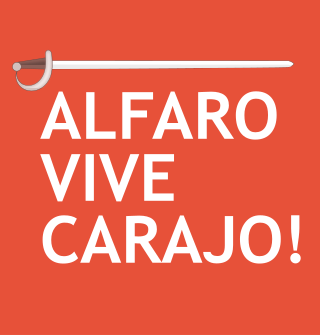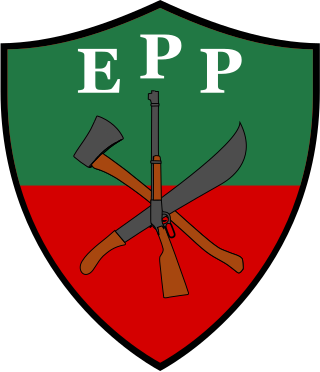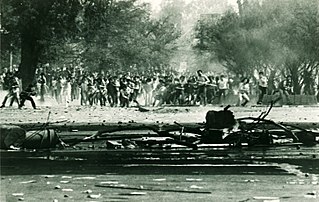
The Revolutionary Armed Forces of Colombia – People's Army was a Marxist–Leninist guerrilla group involved in the continuing Colombian conflict starting in 1964. The FARC-EP was officially founded in 1966 from peasant self-defense groups formed from 1948 during the "Violencia" as a peasant force promoting a political line of agrarianism and anti-imperialism. They are known to employ a variety of military tactics, in addition to more unconventional methods, including terrorism.

The Shining Path, self-named the Communist Party of Peru, is a far-left political party and guerrilla group in Peru, following Marxism–Leninism–Maoism and Gonzalo Thought. Academics often refer to the group as the Communist Party of Peru – Shining Path to distinguish it from other communist parties in Peru.

The Túpac Amaru Revolutionary Movement was a Peruvian Marxist-Leninist guerrilla army which started in the early 1980s. Their self-declared goal was to demonstrate to leftist groups in Peru that sought change through the current government the viability of radical revolution. The MRTA also aimed to provide an alternative to another militant group, the Shining Path, which placed them in direct competition. The group was led by Víctor Polay Campos until he was sentenced to 32 years' imprisonment in 1992 and by Néstor Cerpa Cartolini until his death in 1997.
The Japanese Red Army was a militant communist organization active from 1971 to 2001. It was designated a terrorist organization by Japan and the United States. The JRA was founded by Fusako Shigenobu and Tsuyoshi Okudaira in February 1971, and was most active in the 1970s and 1980s, operating mostly out of Lebanon with PFLP collaboration and funding from Muammar Gaddafi's Libya, as well as Syria and North Korea.

The People's Revolutionary Army was the military branch of the communist Workers' Revolutionary Party in Argentina.
Simón Trinidad is the alias of Juvenal Ovidio Ricardo Palmera Pineda, a high-ranking member of the former Revolutionary Armed Forces of Colombia (FARC), and reputedly the first high-ranking member of that guerrilla group to be captured. "Simón Trinidad" is currently serving a 60-year sentence in solitary confinement in the United States at ADX Florence "Supermax" prison near Florence, Colorado with a scheduled release date of February 17, 2055.

The National Liberation Army is a Marxist–Leninist guerrilla insurgency group involved in the continuing Colombian conflict, which has existed in Colombia since 1964. The ELN advocates a composite communist ideology of Marxism-Leninism and liberation theology. In 2013, it was estimated that the ELN forces consisted of between 1,380 and 3,000 guerrillas. According to former ELN national directorate member Felipe Torres, one fifth of ELN supporters have taken up arms. The ELN has been classified as a terrorist organization by the governments of Colombia, the United States, Canada, New Zealand, and the European Union.

The National Liberation Movement – Tupamaros was a Marxist-Leninist urban guerrilla group in Uruguay in the 1960s and 1970s. In 1989 it joined the Movement of Popular Participation (MPP), which was admitted to the Broad Front.

The Revolutionary Left Movement is a Chilean far-left Marxist-Leninist communist party and former urban guerrilla organization founded on 12 October 1965. At its height in 1973, the MIR numbered about 10,000 members and associates. The group emerged from various student organizations, mainly from University of Concepción, that had originally been active in the youth organization of the Socialist Party. They established a base of support among the trade unions and shantytowns of Concepción, Santiago, and other cities. Andrés Pascal Allende, a nephew of Salvador Allende, president of Chile from 1970 to 1973, was one of its early leaders. Miguel Enríquez was the General Secretary of the party from 1967 until his assassination in 1974 by the DINA.

¡Alfaro Vive, Carajo! (AVC), another name for the Fuerzas Armadas Populares Eloy Alfaro, was a clandestine left-wing group in Ecuador, founded in 1982 and named after popular government leader and general Eloy Alfaro. The group was labeled as a terrorist organization by the Ecuadorian state during the period of the former president León Febres Cordero. It existed between 1983 and 1991, when it carried out various armed actions and criminal acts in Ecuador, with Colombian (M-19) and Nicaraguan influence. The group was initially formed sometime in the 1970s, but was not active militarily for the first few years of the 80's.

Víctor Julio Suárez Rojas — a.k.a. Jorge Briceño Suárez a.k.a. Mono Jojoy — was a high-ranking member of the Revolutionary Armed Forces of Colombia (FARC), a Colombian guerrilla organization. He was second-in-command to Alfonso Cano and top military commander. Suárez Rojas commanded the Eastern Bloc of the FARC and was a member of the FARC Secretariat. His nom de guerre was Jorge Briceño Suárez; to the Colombian army he was known as Mono Jojoy.

The Peruvian Civil War of 1980–2000 was an armed conflict between the Government of Peru and the Maoist guerilla group Shining Path. The conflict's main phase began on 17 May 1980 and ended in December 2000. From 1982 to 1997 the Túpac Amaru Revolutionary Movement waged its own insurgency as a Marxist–Leninist rival to the Shining Path.

Zarate Willka Armed Forces of Liberation was a Bolivian guerrilla terrorist group which was organized about 1985 and surfaced with a series of bombings, assassinations, and attempted assassinations in La Paz, Bolivia, during 1988 and 1989.
Óscar Daniel Zamora Medinaceli was a Bolivian politician and lawyer. A communist student activist in his youth and leader of a failed Maoist insurgency in the 1970s, Zamora Medinaceli went on to become a senator, minister, mayor, ambassador and prefect.

The Paraguayan People's Army is a Marxist-Leninist guerrilla group that officially operates in Paraguay since March 1, 2008, although its antecedents go back as far as the 1990s, acting at that time as the "clandestine armed wing" of Patria Libre.

Following the 1973 Chilean coup d'état, an armed leftist resistance movement against Augusto Pinochet's dictatorship developed until 1990 when democracy was restored. This conflict was part of the South American theater in the Cold War, with the United States backing the Chilean military and the Soviet Union backing the guerrillas. The main armed resistance groups of the period were the Revolutionary Left Movement (MIR) and Frente Patriótico Manuel Rodríguez (FPMR), the armed wing of the Communist Party of Chile. These groups had a long-standing rivalry, including over Marxist orthodoxy and its implementation.

The insurgency in Paraguay, also known as the Paraguayan People's Army insurgency and the EPP rebellion, is an ongoing low-level armed conflict in northeastern Paraguay. Between 2005 and the summer of 2014, the EPP campaign resulted in at least 50 deaths, the majority of them local ranchers, private security guards, and police officers, along with several insurgents. During that same period the group perpetrated 28 kidnappings for ransom and a total of 85 "violent acts".
Terrorism in Bolivia has occurred since the 1960s and continues sporadically until the present. A number of bombings targeted public places, such as bank branches, ATM's, commercial institutions and interests generally leaving material damage.
Guillermo Capobianco Ribera was a Bolivian lawyer, writer and politician.
The Anarchic Cell For Revolutionary Solidarity was an anarchist urban guerrilla group that was active in the city of La Paz, where it carried out several explosive attacks in the first half of 2012, causing material damage.













